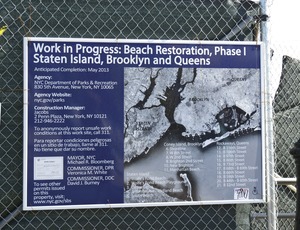
New York City aims to ramp up protection against damage from catastrophic weather events and a changing climate with a new $19.5-billion plan to strengthen 15 critical areas, from food supply to health care to shorelines. The plan, which Mayor Michael Bloomberg (R) revealed on June 11 in a 438-page report, offers long-term recommendations and goes far beyond Superstorm Sandy reconstruction.
"For all of these 15 areas, the report takes a top-to-bottom look at their infrastructure, their governance, how they were impacted by Sandy, the most significant risks that they face due to climate change and what exactly we can do to better prepare them for it," Bloomberg said. Resiliency, he said, is the underlying goal of the report.
Based on the mayor's existing green initiative, called "PlaNYC," the report also offers proposals to rebuild the city's Sandy-pummeled coastal regions. Among more than 250 recommendations, it calls for increasing coastal edge elevations by raising bulkheads in targeted locations.
The proposal also includes several competitions for engineering and construction innovations.
These include a global design contest later this year aimed at developing efficient and cost-effective integrated flood-protection systems. Winners will proceed to the design-and-construction phase in 2014.
Another contest, which the city intends to launch this summer, will allocate grants for technology projects that further either building or infrastructure resiliency.
Industry-related professionals are still reviewing the report, but one local expert, Bud Griffis, professor of civil engineering and construction at New York University's Polytechnic Institute, Brooklyn, says he likes what he sees.
"Some [of the recommendations] make sense and some don't. But overall, I like the idea of flood-proofing over building a great big structure in the harbor," an idea that was previously suggested for flood protection, Griffis says.
Industry groups generally welcomed the report, calling it an ambitious undertaking, but some expressed disappointment that it does not address labor concerns.
"One thing that it doesn't appear to mention is making sure that construction is done efficiently and on a cost-conscious basis," says Steve Lefebvre, president of the Associated Builders and Contractors' New York state chapter, an open-shop group. State and local government should ensure that "all firms, including open-shop contractors, have a fair chance of winning bids on these projects," he says.
Richard Anderson—president of the New York Building Congress, which recently published its own post-Sandy rebuilding study—also notes what is "missing."
He says Mayor Bloomberg "emphasized the importance of reliable electricity and hardening the power grid, but he didn't talk about any public funding to make that happen." The group, whose representatives offered suggestions to the team developing the report, supports public-private partnerships for such work.
Meanwhile, the Federal Emergency Management Agency issued on June 10 its long-awaited preliminary work maps for New York City. Many businesses and homeowners were eagerly awaiting specific guidelines on elevating buildings, thus qualifying them for lower flood insurance rates.
The maps are FEMA's latest refinements to its ongoing flood-hazard analysis; they are "more or less what the final maps will be" when issued in 2015, says Arthur Lighthall, general manager of the Breezy Point Cooperative in Queens, an area in the Rockaway Beach peninsula that Sandy devastated.
Many homeowners have put off rebuilding until the release of the maps, Lighthall says.
"Homeowners who need to rebuild were waiting for [these maps as] a final determination of how high they would have to go and to find out the nature of the mechanisms they could use to elevate their homes," he says. The maps require those in the worst flood zones to use driven piles for elevation, he adds.


Post a comment to this article
Report Abusive Comment